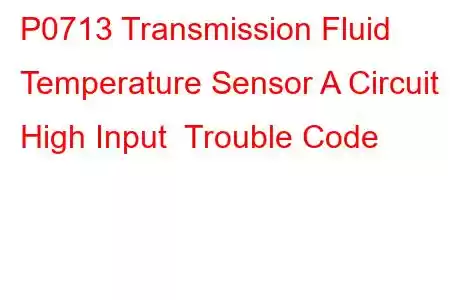P0713 Trans Fluid Temp Sensor A Circuit High Input
OBD-II Trouble Code Technical Description
Transmission Fluid Temperature Sensor A Circuit High Input
What does that mean?
This diagnostic trouble code (DTC) is a generic powertrain code, which means it applies to OBD-II equipped vehicles which have a transmission fluid temperature sensor (Jeep, Ford, Nissan, Toyota, Honda, Infiniti, Acura, Jaguar, Lexus, etc.). Although generic, the exact repair steps may vary depending on make/model.
The transmission fluid temperature sensor (TFT) sensor produces a signal that is used by the powertrain control module (PCM) to determine shift points, line pressure and torque converter clutch (TCC) control. The sensor is often located in the transmission oil pan.
The TFT sensor receives a reference voltage (usually 5 volts) from the PCM. It the varies its internal resistance in relation to transmission fluid temperature to send a return voltage signal to the PCM. TFT sensors are a type of negative temperature coefficient (NTC) thermistor. This means internal resistance of the sensor is inversely proportional to the oil temperature. The TFT sensor signal voltage goes down when the transmission fluid temperature goes up and vice versa.
Code P0713 is set when the PCM detects a high transmission fluid temperature sensor signal. This usually indicates an open circuit.
An example of a transmission fluid temperature sensor:
Related trans fluid temperature sensor "A" circuit codes:
P0710 Transmission Fluid Temperature Sensor A Circuit Malfunction P0711 Transmission Fluid Temperature Sensor A Circuit Range/Performance P0712 Transmission Fluid Temperature Sensor A Circuit Low Input P0714 Transmission Fluid Temperature Sensor A Circuit IntermittentCode Severity & Symptoms
The severity of this code is moderate to severe. In some cases, this code can indicate a transmission problem. It's a good idea to address this code as soon as possible.
Symptoms of a P0713 engine code may include:
Illuminate check engine light Improper torque converter clutch operation Harsh or delayed shifts Vehicle stuck in limp modeCauses
Causes for this trouble code may include:
Faulty transmission fluid temperature sensor Transmission problems Wiring problems Faulty PCMDiagnostic and Repair Procedures
Begin by visually inspecting the transmission fluid temperature sensor and the corresponding wiring. Look for loose connections, damaged wiring, etc. If damage is found, repair as necessary, clear the code and see if it returns. Next, check for technical service bulletins (TSBs) regarding the issue. If nothing is found, you will need to move forward to step by step diagnosis of the system.
The following is a generalized procedure, as testing for this code varies between vehicles. To accurately test the system, you'll want to refer to the manufacturer's diagnostic flow chart.
Do some preliminary circuit testing
Use a scan tool to monitor the transmission temperature sensor data parameter. Disconnect the TFT sensor; the scan tool value should drop to a very low value. Next, connect a jumper wire across the terminals. If the scan tool now displays a very high temperature, the connections are sound and the ECM can recognize the input. This means the problem is most like the sensor and not a circuit or PCM problem.
Test the sensor
Disconnect the transmission fluid temperature sensor connector. Next, measure the resistance between the two sensor terminals using a digital multimeter set to ohms. Start the engine and watch the meter value; the values should decrease smoothly as the engine warms up (check the engine temperature gauge on the dash to ensure the engine reaches operating temperature). If engine temperature increases but TFT resistance does not decrease, the sensor is fau
Read: 29


